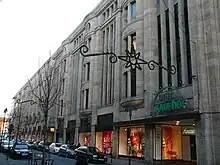Tietz Department Store (Elberfeld)


The Tietz department store in Wuppertal-Elberfeld (today Galeria Kaufhof) is a historically significant department store building that was seized from its Jewish owners under the Nazis.
Early history
The Tietz department store was cofounded by Hermann Tietz (1837-1907) in 1882.[1]
The building was designed by Wilhelm Kreis, one of the leading architects of the time, who also designed the Bismarck Tower in Wuppertal, on behalf of Leonhard Tietz AG as a multi-department store based on the French model.[2] It was built in 1911/1912 and opened on April 24, 1912, at Neumarkt in Elberfeld (today No. 26).[3] The immense variety of goods under one roof offered the population of the time a completely new shopping experience. Prior to this, a first branch existed on Herzogstrasse from 1885, which was considered Germany's first department store.
Nazi-era seizure
When the Nazis came to power in Germany in 1933, the Tietz were persecuted because of their Jewish heritage. The store was boycotted. All businesses of the Tietz family were "Aryanized" (i.e., seized from Jews and transferred to non-Jewish owners) and the family members emigrated. The Tietz department store was "aryanised" in 1934.[4][5][6][7]
Oscar Tietz's son Martin Tietz migrated with his wife to Liechtenstein in 1939 and his assets were seized by the Gestapo.[3]
In 1933, Georg Karg, the new non-Jewish owner, changed the company's name to "Hertie Department Stores" as an abbreviation of Hermann Tietz. Oscar Tietz's son-in-law, Hugo Zwillenberg was arrested by the Gestapo in 1938, imprisoned in the Sachsenhausen concentration camp for three weeks after which he and emigrated to the Netherlands.[8]
Postwar
The department store, which was partially destroyed during the war, was rebuilt after 1945. The striking sandstone facade on Neumarkt had to give way to a steel construction, but the north facade on today's Neumarktstrasse was preserved.
The implementation of the Galeria concept of the Kaufhof company took place in 2000.
Literature
- Max Creutz: Das Warenhaus Tietz in Elberfeld, von Prof. Wilhelm Kreis …. X. Sonderheft der Architektur des XX. Jahrhunderts. Ernst Wasmuth, Berlin 1912. Online
- Hermann J. Mahlberg, Hella Nußbaum: Aufbruch um 1900 und die Moderne in der Architektur des Wuppertals. Abendrot einer Epoche. Müller+Busmann, Wuppertal 2008.
- Michael Okroy: Volksgemeinschaft, Erbkartei und Arisierung. Ein Stadtführer zur NS-Zeit in Wuppertal. Wuppertal 2008².
- Das Warenhaus Tietz in Wuppertal – Tempel des Konsums und Ort der Moderne. Illustr. Broschüre, hrsg. vom Trägerverein Begegnungsstätte Alte Synagoge Wuppertal e.V., Wuppertal 2012
References
- "Tietz Department Store Celebrates Fiftieth Anniversary". Jewish Telegraphic Agency. 1932-03-04. Retrieved 2022-02-21.
- Creutz, Max (1912). Das Warenhaus Tietz in Elberfeld von Prof. Wilhelm Kreis (in German). Berlin: Wasmuth. OCLC 602180431.
- "Leonhard-Tietz-Gedenktafel - Denkmal-Wuppertal.de" (in German). Retrieved 2022-02-21.
- "Wiesbaden Museum restitutes two paintings to the heirs of Martin Tietz". www.lootedart.com. Retrieved 2022-02-21.
Martin Tietz was one of the owners of Hermann Tietz department store which was "aryanised" in 1934.
- "The Attack on Berlin Department Stores (Warenhaeuser) After 1933" (PDF).
- "Survivors Will Get 5,000,000 Marks Compensation for "aryanized" Famous Dept. Store". Jewish Telegraphic Agency. 1951-04-02. Retrieved 2022-02-21.
- "Foreign Claims Settlement Commission of the United States" (PDF). .justice.gov.
- "History of the Hertie Foundation". www.ghst.de. Retrieved 2022-02-21.
External links
- "Denkmalliste". www.wuppertal.de. Retrieved 10 March 2022.